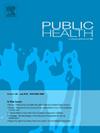新诊断糖尿病患者心血管疾病发病前代谢危险因素的轨迹
IF 3.9
3区 医学
Q1 PUBLIC, ENVIRONMENTAL & OCCUPATIONAL HEALTH
引用次数: 0
摘要
许多研究表明,多种代谢危险因素(MRFs)可预测糖尿病患者的心血管疾病(CVD),但这些标志物在CVD发病前的变化尚未得到很好的表征。我们的目的是探索新诊断的糖尿病患者在CVD发生前各种MRFs的轨迹。研究设计前瞻性队列研究。方法我们在开滦队列中选择了7个周期的21798例新诊断的糖尿病患者。在CVD诊断前每两年测量一次磁共振成像。我们使用混合效应模型分别构建了16个MRFs的轨迹。结果在长达15年的随访期间,总共发生了2105例CVD事件。发生心血管疾病的参与者在基线和随访期间的大多数MRFs不良水平高于未发生心血管疾病的参与者。在CVD诊断前,空腹血糖、胰岛素抵抗、脉压、心率、肝功能和炎症生物标志物呈线性升高,而胰岛素敏感性、脂质谱、肥胖指数和舒张压呈线性下降。作为预测心血管疾病最重要的指标之一,收缩压呈二次增长。结论在新诊断的糖尿病患者中,在CVD发生之前MRFs水平就已处于不利水平。关键mrf,包括TyG指数、VAI、收缩压和脉压,随着时间的推移逐渐增加,并且与非心血管疾病人群相比仍然较高。这突出表明需要进行早期预防,以减轻糖尿病患者心血管并发症的负担。本文章由计算机程序翻译,如有差异,请以英文原文为准。
Trajectories of metabolic risk factors prior to the onset of cardiovascular disease in patients with newly diagnosed diabetes
Objectives
Many studies have demonstrated that multiple metabolic risk factors (MRFs) predict cardiovascular disease (CVD) in patients with diabetes, but changes in these markers before CVD onset are not well characterized. We aimed to explore the trajectories of various MRFs before the occurrence of CVD in patients with newly diagnosed diabetes.
Study design
Prospective cohort study.
Methods
We selected 21,798 patients with newly diagnosed diabetes from seven cycles in the Kailuan cohort. MRFs were measured at two-year intervals prior to CVD diagnosis. We used the mixed effects models to construct trajectories for 16 MRFs respectively.
Results
During up to 15 years of follow-up, a total of 2,105 CVD events occurred. Participants who developed CVD had more adverse levels of most MRFs at baseline and during follow-up than those who did not develop CVD. Before CVD diagnosis, fasting plasma glucose, insulin resistance, pulse pressure, heart rate, liver function, and inflammatory biomarkers showed linear increases, while insulin sensitivity, lipids profiles, obesity indices, and diastolic blood pressure showed linear decreases. Systolic blood pressure, as one of the most important components in predicting CVD, showed a quadratic increase.
Conclusions
In patients with newly diagnosed diabetes, unfavorable levels of MRFs were present before CVD developed. Key MRFs, including the TyG index, VAI, SBP, and pulse pressure, progressively increased over time and remained higher compared to non-CVD populations. This highlights the need for early prevention to reduce the burden of cardiovascular complications in diabetes.
求助全文
通过发布文献求助,成功后即可免费获取论文全文。
去求助
来源期刊

Public Health
医学-公共卫生、环境卫生与职业卫生
CiteScore
7.60
自引率
0.00%
发文量
280
审稿时长
37 days
期刊介绍:
Public Health is an international, multidisciplinary peer-reviewed journal. It publishes original papers, reviews and short reports on all aspects of the science, philosophy, and practice of public health.
 求助内容:
求助内容: 应助结果提醒方式:
应助结果提醒方式:


